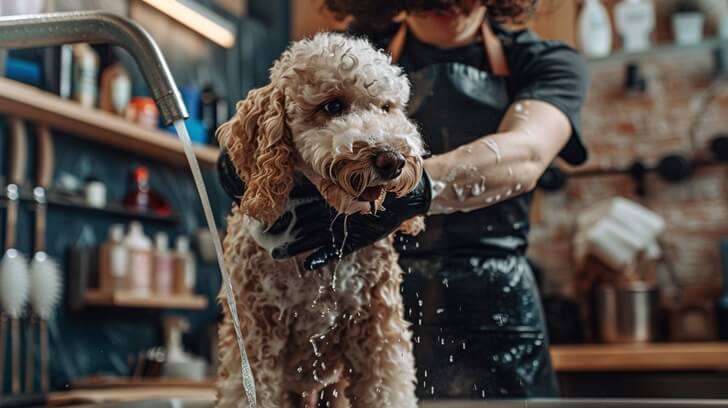
Bathing your dog is an essential part of their overall grooming routine, but the frequency and method can vary greatly depending on the breed, coat type, and lifestyle of your pet. While some dogs seem to need baths every other week, others can go months without a thorough wash. So, how do you determine the right bathing schedule for your dog?
This is a question many pet owners grapple with, often fearing that either over-bathing or under-bathing could harm their furry friends. Bathing too frequently can strip your dog’s skin of natural oils, leading to dryness and irritation. On the other hand, skipping baths for too long can cause matting, skin infections, and an unpleasant odor.
This comprehensive guide will delve into the factors that determine how often you should bathe your dog, particularly focusing on their coat type. By the end of this article, you’ll know exactly how to balance cleanliness and health, ensuring your dog’s skin and coat remain in optimal condition. Let’s explore the benefits of regular bathing, common mistakes to avoid, and the best methods to keep your dog looking and feeling their best.
Benefits of Bathing Your Dog Properly: Why You Should Bathe Your Dog
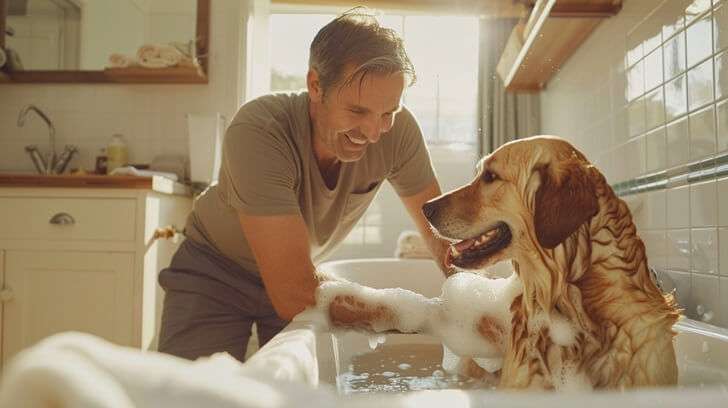
Bathing your dog isn’t just about making them smell better or keeping them clean after a muddy romp in the yard. A regular bathing schedule, done correctly, offers several health and hygiene benefits that can improve your dog’s quality of life. Below are the main benefits that come with giving your dog a bath at the right intervals.
1. Promotes Healthy Skin and Coat: One of the most crucial reasons to bathe your dog is to maintain healthy skin and a vibrant coat. Dogs naturally produce oils that keep their skin moisturized and their coat shiny. However, dirt, allergens, and dead skin can accumulate over time, especially if your dog spends a lot of time outdoors. A proper bathing routine helps remove debris and excess oils, preventing clogged pores, dry patches, and itchiness.
By keeping their skin clean, you also reduce the risk of infections caused by bacteria, yeast, or parasites. Dogs with skin conditions, such as allergies or dermatitis, can benefit from specialized medicated baths that soothe irritation and prevent flare-ups. Even for dogs with no specific skin issues, maintaining a clean coat helps ensure that their skin stays healthy and nourished.
2. Controls Shedding and Reduces Loose Hair: If you own a dog, you’ve probably battled with shedding at some point. While shedding is a natural part of your dog’s life cycle, a proper bathing routine can help reduce the amount of loose hair that ends up on your clothes, furniture, and carpets. Regular baths, paired with brushing, remove dead hairs that would otherwise fall out around your home.
Bathing can also prevent shedding from becoming excessive, which might indicate an underlying skin issue or a lack of proper grooming. Dogs with double coats, such as Golden Retrievers and Huskies, benefit particularly from routine baths followed by thorough de-shedding during the grooming process.
3. Prevents Matting in Long-Haired Breeds: For dogs with long or curly hair, such as Shih Tzus, Poodles, and Maltese, regular baths are essential to prevent matting. Mats form when the hair becomes tangled and knotted, often leading to discomfort and skin issues. Once mats form, they are difficult to remove and can pull at the dog’s skin, causing irritation or even infection.
Bathing your long-haired dog every few weeks, along with consistent brushing, will help keep their coat free of tangles and mats. After each bath, use a leave-in conditioner and brush their fur while blow-drying to ensure it stays smooth and manageable.
4. Controls Odors: No matter how much you love your dog, their natural smell can sometimes become overwhelming, particularly for dogs who love to roll in mud, grass, or worse. Regular baths help keep your dog smelling fresh, making those snuggles and playtime moments more enjoyable. Bathing is especially important for dogs with skin folds or ears prone to infection, as these areas can trap moisture and develop unpleasant odors if not cleaned properly.
Bathing with a good-quality dog shampoo neutralizes these smells and reduces the buildup of bacteria and yeast, keeping your dog smelling fresh for longer.
5. Allows for Early Detection of Skin Issues: Regular bathing offers the perfect opportunity to inspect your dog’s skin for any abnormalities. During bath time, you can check for lumps, bumps, rashes, or parasites like fleas and ticks. Early detection of these issues allows for timely treatment and can prevent more severe health problems down the line.
For example, if you notice that your dog has developed dry, flaky patches of skin, it could be an indication of a dermatological condition that requires a vet’s attention. Alternatively, regular bathing can help you spot the early signs of parasites or infections that could otherwise go unnoticed under their coat.
How to Bathe Your Dog Based on Coat Type: A Step-by-Step Guide
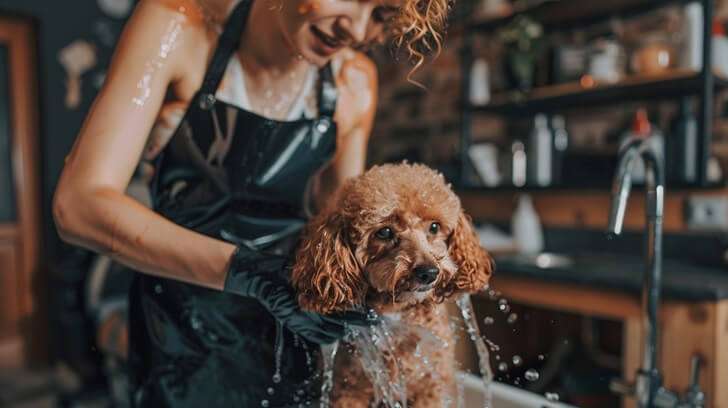
Not all dogs are created equal when it comes to their coat care. The type of fur or hair your dog has will dictate how often they should be bathed, the type of products you should use, and the overall grooming routine that best suits them. Below is a detailed guide on how to bathe your dog based on their coat type.
1. Short-Coated Dogs (Labradors, Beagles, Boxers)
Short-coated dogs are relatively low maintenance when it comes to grooming. Their fur doesn’t tangle easily, and they don’t produce as much oil as dogs with thicker coats. You should aim to bathe your short-coated dog every 4 to 6 weeks, or more frequently if they get especially dirty.
Steps for Bathing Short-Coated Dogs:
- Brush before bathing: While short-coated dogs don’t require extensive brushing, running a brush through their coat before a bath helps remove loose hairs and dirt.
- Use a mild dog shampoo: Short coats are sensitive to harsh shampoos, so choose a product that’s gentle on the skin and doesn’t strip away essential oils.
- Thoroughly rinse off all shampoo: Shampoo residue can cause itching and irritation if left on your dog’s skin. Be sure to rinse thoroughly.
- Dry with a towel or hairdryer: Short-coated dogs dry relatively quickly, but using a blow dryer on a low setting can help speed up the process and ensure they are completely dry.
2. Double-Coated Dogs (Huskies, Golden Retrievers, German Shepherds)
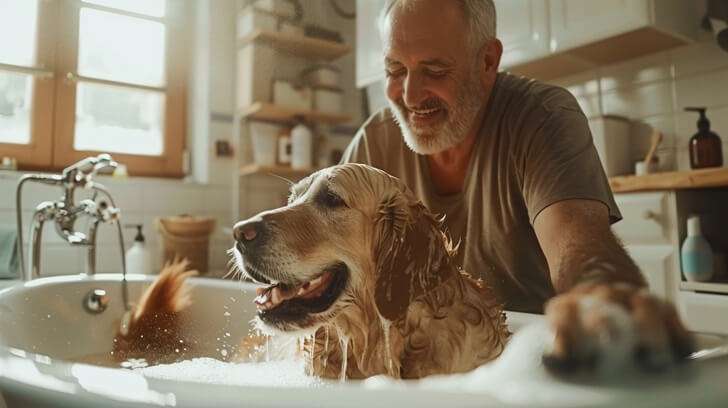
Double-coated dogs have both an insulating undercoat and a water-resistant topcoat, which requires more effort to clean. These dogs should be bathed every 6 to 8 weeks to prevent dirt buildup and maintain their coat’s natural insulating properties.
Steps for Bathing Double-Coated Dogs:
- Brush thoroughly before the bath: De-shedding your dog before the bath helps to remove dead undercoat hair and prevents matting.
- Use a de-shedding shampoo: Specialized de-shedding shampoos help loosen dead hair during the bath.
- Dry thoroughly: Be sure to dry the undercoat completely, as moisture trapped in the coat can lead to skin infections. A blow dryer is essential for these breeds.
3. Long-Coated Dogs (Shih Tzus, Maltese, Afghan Hounds)
Long-coated breeds need more frequent baths—usually every 4 to 6 weeks—to keep their coats smooth and tangle-free. Skipping baths for too long can lead to severe matting, which can cause discomfort and even skin issues.
Steps for Bathing Long-Coated Dogs:
- Detangle before the bath: Always brush out any mats or tangles before bathing, as water can make them harder to remove.
- Use conditioner: Apply a conditioner after shampooing to keep the coat soft and smooth.
- Blow-dry with a brush: Use a blow dryer while brushing to prevent tangles from reforming.
4. Curly-Coated Dogs (Poodles, Bichon Frises)
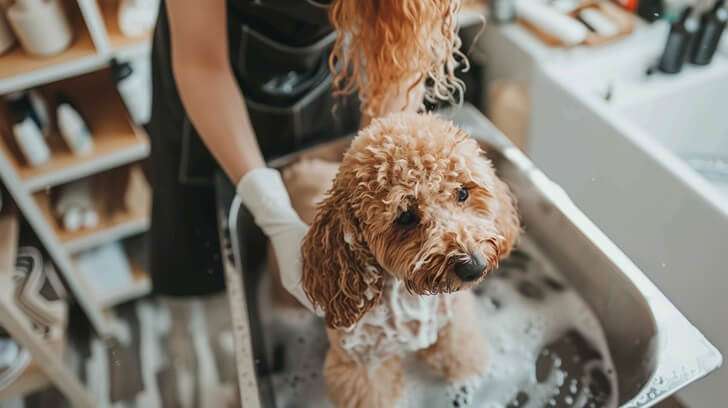
Curly coats can trap dirt and moisture, leading to matting if not properly cared for. These dogs should be bathed every 3 to 4 weeks to keep their coat healthy.
Steps for Bathing Curly-Coated Dogs:
- Use a moisturizing shampoo: Curly-coated dogs can develop dry skin, so opt for a moisturizing shampoo.
- Condition after shampooing: Curly coats benefit from conditioners that prevent frizz and dryness.
- Blow-dry with care: Use a blow dryer on a low setting and fluff the coat with a brush to maintain the curl’s texture.
5. Hairless Breeds (Chinese Crested, Xoloitzcuintli)
Hairless breeds require frequent baths—typically every 2 to 3 weeks—to maintain skin health. Their skin is prone to dryness and sunburn, so proper skincare is crucial.
Steps for Bathing Hairless Breeds:
- Use a gentle cleanser: Opt for a sensitive-skin cleanser designed for dogs.
- Moisturize after the bath: Apply a dog-safe moisturizer to prevent dryness and irritation.
- Avoid sun exposure after bathing: Hairless breeds can be more prone to sunburn right after a bath, so ensure they are protected if going outdoors.
Common Mistakes and Challenges to Avoid When Bathing Your Dog

Bathing your dog seems like a simple task, but there are several common mistakes that pet owners make which can lead to skin irritation, coat damage, or other issues. Here’s how to avoid them:
1. Overbathing Your Dog: One of the most common mistakes is bathing your dog too frequently. While it might seem like a good idea to keep them clean, overbathing can strip the natural oils from their skin, leading to dryness, irritation, and even skin infections. Make sure to stick to a bathing schedule that is appropriate for your dog’s coat type and lifestyle. For most dogs, every 4 to 8 weeks is sufficient unless they have specific needs.
2. Using Human Shampoo: Another frequent error is using human shampoo instead of dog-specific products. Human shampoos are formulated for human skin, which has a different pH level than canine skin. This can lead to irritation, allergic reactions, and skin problems. Always choose a shampoo that is specifically designed for dogs to ensure their skin stays healthy and balanced.
3. Skipping the Brush: Many pet owners neglect to brush their dog before a bath. Brushing is essential for removing loose hairs, dirt, and mats before getting wet. Skipping this step can cause tangles to tighten and become more difficult to remove after bathing. Always brush your dog thoroughly before bathing to make the process easier and more effective.
4. Not Rinsing Thoroughly: Failing to rinse out all the shampoo can cause residue to remain on your dog’s coat, which can lead to itching and irritation. Take the time to rinse thoroughly until the water runs clear. This ensures that no shampoo is left behind and helps to maintain a healthy coat.
5. Neglecting Ears and Paws: Many owners forget to clean their dog’s ears and paws during bath time. These areas can trap dirt and moisture, leading to infections if not properly cared for. Use a damp cloth to wipe the paws and a cotton ball to gently clean the ears (never insert anything into the ear canal).
6. Not Monitoring Water Temperature: Bathing your dog in water that is too hot or too cold can cause discomfort. Always check the water temperature before bathing, aiming for lukewarm water that is comfortable to the touch. This will ensure your dog has a pleasant bathing experience and helps them relax during the process.
Scientific Backing: Studies on Proper Dog Bathing

While many pet owners rely on anecdotal evidence regarding bathing practices, several studies back the recommendations made here.
Skin Health and Bathing: Research conducted by the American Veterinary Medical Association (AVMA) suggests that regular grooming, including bathing, can significantly impact the overall health of a dog’s skin. A study published in the Veterinary Dermatology Journal highlighted that dogs subjected to regular grooming had lower incidences of skin issues compared to those who were not groomed consistently. This underscores the importance of establishing a proper bathing routine based on a dog’s specific needs.
Benefits of Medicated Baths: In cases of skin disorders, medicated baths have been proven effective. A study in the Journal of Veterinary Dermatology indicated that medicated shampoos containing chlorhexidine and miconazole significantly reduced the severity of skin infections in dogs. This illustrates that for dogs with particular skin concerns, a tailored bathing approach can yield positive results.
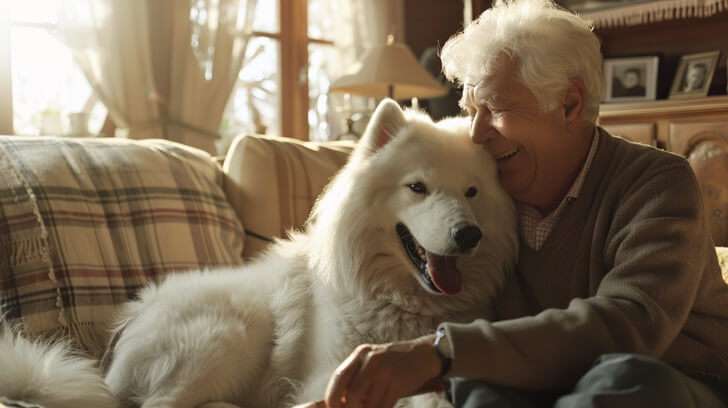
The Psychological Aspect of Bathing: Bathing can also have psychological benefits for dogs. A study conducted by researchers at the University of Bristol found that dogs with consistent grooming routines tend to exhibit less anxiety and behavioral issues. This may be because they become accustomed to the handling and care, leading to a more trusting relationship with their owners.
Conclusion
Maintaining your dog’s hygiene through regular bathing is essential not just for their appearance but for their overall health and well-being. By understanding the specific needs based on your dog’s coat type, you can ensure that they receive the appropriate care they deserve. Remember, it’s important to find the right balance—bathe them often enough to keep them clean, but not so often that you strip their coat of essential oils.
If you found this guide helpful and want to further enhance your dog training knowledge, consider purchasing the Dog Trainer Bible. This comprehensive resource is packed with valuable tips and techniques to improve your dog’s behavior and training experience. Start giving your furry friend the care they deserve today!
